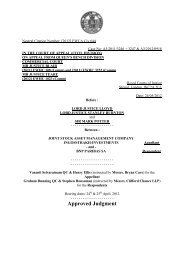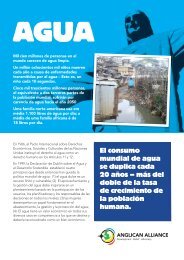Business Advantages of Supporter Community ... - Supporters Direct
Business Advantages of Supporter Community ... - Supporters Direct
Business Advantages of Supporter Community ... - Supporters Direct
Create successful ePaper yourself
Turn your PDF publications into a flip-book with our unique Google optimized e-Paper software.
4 Developing Facilities<br />
Key Question:<br />
Has community ownership helped with development <strong>of</strong> facilities<br />
Top Three Findings<br />
i) <strong>Supporter</strong> community ownership assists clubs in getting commitment<br />
from key public sector partners – especially local authorities – because<br />
there is a level <strong>of</strong> protection <strong>of</strong> public benefit and transparency that<br />
private companies do not provide; as well as an alignment <strong>of</strong> public<br />
benefit agendas.<br />
ii) Assistance from local authorities ranges from provision <strong>of</strong> land, funding<br />
and ‘in kind’ support for ongoing strategic partnerships and deployment<br />
<strong>of</strong> planning regulations to protect assets from speculators.<br />
iii) <strong>Supporter</strong> community ownership – in the form <strong>of</strong> community benefit<br />
societies – also allows clubs to raise finance for facilities in innovative<br />
ways that do not jeopardise the long term future <strong>of</strong> the club and cement<br />
the community benefit function <strong>of</strong> facilities developed.<br />
The business advantages <strong>of</strong> being a supporter community owned club are<br />
particularly striking in the area <strong>of</strong> facility development. Evidence gathered<br />
The strategic, financial and in<br />
kind support <strong>of</strong> local authorities<br />
has been a key feature <strong>of</strong> facility<br />
development by supporter<br />
community owned clubs.<br />
as part <strong>of</strong> this piece <strong>of</strong> work as well<br />
as during the Social and <strong>Community</strong><br />
Value <strong>of</strong> Football research suggests that<br />
they would not have their new facility<br />
development if they had not been<br />
supporter-owned.<br />
The strategic, financial and in kind<br />
support <strong>of</strong> local authorities has been a key feature <strong>of</strong> facility development<br />
by supporter community owned clubs; because authorities can rely on<br />
the community benefit function <strong>of</strong> clubs; and their open and democratic<br />
ownership structure. This type <strong>of</strong> reliance is simply not possible with<br />
privately owned clubs.<br />
In addition, there are distinct advantages to a CBS structure. One <strong>of</strong> these is<br />
that clubs that are supporter community owned can raise significant finance<br />
for facilities via shares in the society. This is explored in greater depth in<br />
<strong>Supporter</strong>s <strong>Direct</strong>’s Briefing Paper No.3 on raising finance 9 .<br />
9 See also Development Trust Association and Co-ops UK (2010) Investing in <strong>Community</strong><br />
Shares and www.communityshares.org.uk for further information. Add to footnote. See also,<br />
Jaquiss, K and Walsh, A (2011) Punk Finance: Capital Made Mutual, London: Mutuo<br />
<strong>Business</strong> <strong>Advantages</strong> <strong>of</strong> <strong>Supporter</strong> <strong>Community</strong> Ownership 21





![[2012] UKUT 399 (TCC)](https://img.yumpu.com/51352289/1/184x260/2012-ukut-399-tcc.jpg?quality=85)





![Neutral Citation Number: [2009] EWHC 3198 (Ch) Case No: CH ...](https://img.yumpu.com/50120201/1/184x260/neutral-citation-number-2009-ewhc-3198-ch-case-no-ch-.jpg?quality=85)





